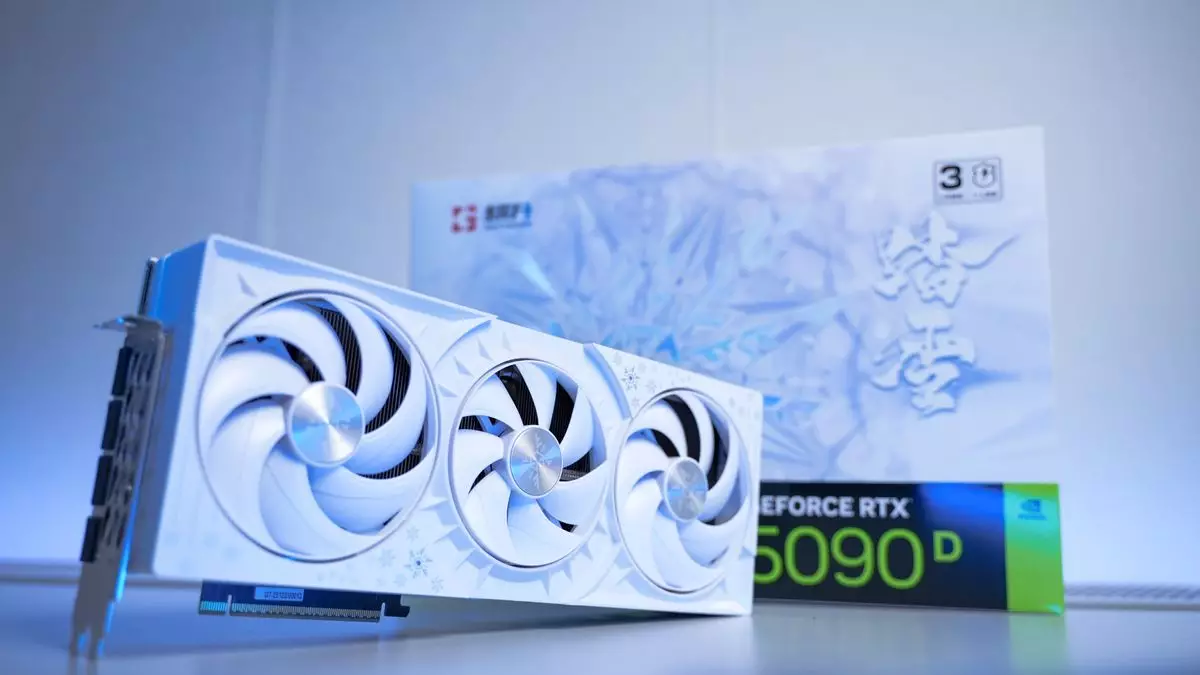The world of gaming technology is on the brink of an exciting transition with the approaching launch of Nvidia’s RTX 50 series graphics cards. Among these highly anticipated releases, Gainward’s stunning RTX 5090 D has captured the attention of hardware enthusiasts and casual gamers alike with its unique design and intriguing implications regarding performance. This article aims to unpack the complex layers of the RTX 5090 D, delving into its aesthetically striking features, underlying performance limitations, and the geopolitical context that has influenced its design and market availability.
Gainward’s RTX 5090 D is visually impressive, a fact that is unlikely to be lost on anyone who sees it. The card boasts an all-white design adorned with delicate snowflakes and sharp, thorn-like embellishments that encircle its central fan. Such a design evokes a wintry, ethereal quality that differentiates it from the standard offerings in the graphics card market. The overt branding of Gainward on the card might typically draw criticism; however, the allure of the product renders this detail more acceptable. It is essential to recognize that the visual appeal of a component can play a significant role in consumer preference—although appearance may not directly enhance performance, it undoubtedly adds value in terms of consumer desire.
Despite being visually captivating, the RTX 5090 D is subject to specific performance constraints. These limitations stem from U.S. export regulations, which require companies to adapt their products for international markets, particularly for China. This adaptation results in lower processing capabilities for the D series, where the total processing performance (TPP) and performance density (TD) are intentionally reduced. While the RTX 5090 D retains the same amount of RAM (32 GB of GDDR7) and CUDA cores (21,760) as its more powerful counterpart, it operates at a reduced capability. This aspect introduces a crucial dichotomy within Nvidia’s product lineup: while aesthetics can seduce, raw performance remains king.
The backdrop of the RTX 5090 D’s design and specifications is deeply intertwined with issues of trade, government sanctions, and market access. Nvidia’s acquisition of Mellanox Technologies triggered a series of responses from regulatory bodies in China, culminating in an antitrust investigation. Although the deal was approved, it came at the price of stringent agreements surrounding technology transfer into the Chinese market. These political dynamics substantially affect Nvidia’s strategy in Asia, prompting them to develop workarounds for affected products like the RTX 5090 D. Therefore, looking beyond the aesthetic and performance to the political context is essential for a comprehensive understanding of this product.
Gainward’s RTX 5090 D exemplifies a growing trend in the gaming technology arena wherein manufacturers tap into exclusivity as a selling point. The card is not only a piece of hardware but also a collectible item, appealing to consumers who enjoy obtaining unique or limited-edition products. This trend is further echoed in collaborations between brands and IPs, such as Razer’s partnership with Pokémon and themed graphics from popular media franchises. The allure of exclusivity extends the desirability factor, encouraging consumers to seek out incarnations of products that may not be readily available in their markets.
While Gainward’s RTX 5090 D may not reign supreme in terms of performance, its breathtaking design, combined with the intricacies of regulatory landscape, makes it a fascinating product within the graphics card market. The card’s aesthetic charm may well sway gamers and collectors alike, even if it doesn’t deliver the full specifications expected of a high-end component. The intersection of technology, geopolitics, and consumer preference underscores the complex reality of modern gaming hardware, reminding us that in this environment, beauty and performance must coexist—sometimes at a cost. The RTX 5090 D, with its icy aesthetic and duality of capability, encapsulates the complexity surrounding next-generation computing.


Leave a Reply